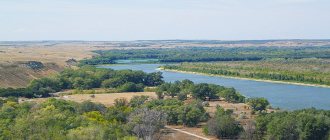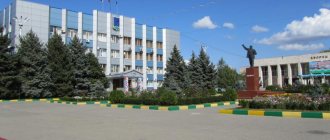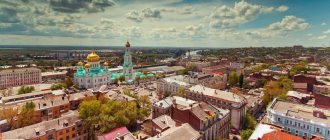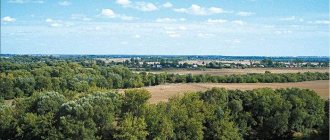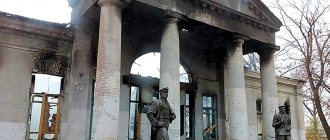Geographical position
In the south of Russia, on the East European Plain and the north of the Caucasus, there is a large subject of the Federation - the Rostov region. Its area is just over 1 million square meters. km, and this is 33rd among all regions of the country. The region borders on the Voronezh and Volgograd regions, Ukraine, Krasnodar and Stavropol territories and Kalmykia. The relief of the region is generally flat: from a slight elevation in the north to a depression in the south. The region is rich in hydro resources. One of the largest rivers in Europe - the Don - and its two tributaries - the Manych and Donets - flow here, there is a large Tsimlyansk reservoir and several lakes. The region is located within the steppe zone; in the south there is a transition to semi-deserts. Most of the territory is occupied by fertile agricultural land, there are few forests, mostly green areas are located in the floodplains of rivers. For many centuries, the life of the population of the Rostov region has been associated with the cultivation of crops and livestock.
Population density by county
There are 9 federal districts in the Russian Federation:
- Central (CFD).
- Southern (Southern Federal District).
- Northwestern (NWFD).
- Far Eastern (FEFD).
- Siberian (Siberian Federal District).
- Ural (Ural Federal District).
- Privolzhsky (Volga Federal District).
- North Caucasus (North Caucasus Federal District).
- Crimean (KFO).
Find out what the average life expectancy of men and women in Russia is here.
Central Federal District
The leader in number among the districts was the Moscow Region. In the Moscow region in 2021 there were 74,318,647 inhabitants. For 1 sq. km of the Moscow region there are 134.91 people.
Population of cities in the Bryansk region
The population of the Bryansk region is 1,225,741 citizens. For 1 sq. km of this region is inhabited by 35.16 people.
Population density of other regions in the Central Federal District:
- Belgorodskaya - 57.13.
- Bryansk - 35.16.
- Vladimirskaya – 48.04.
- Ivanovskaya – 48.04.
- Kaluzhskaya - 33.91.
- Kostroma - 10.82.
- Kursk - 37.34.
- Lipetskaya - 48.08.
- Orlovskaya - 30.82.
- Ryazanskaya - 28.53.
- Smolenskaya - 19.26.
- Tambovskaya - 30.48.
- Tverskaya – 15.50.
- Tula - 58.66.
- Yaroslavskaya - 35.16.
Southern Federal District
The population density of the Rostov region is 41.95 people per square meter. km. The population of the Volgograd region is 2,545,937 inhabitants, and per square meter. km of area there are 22.55 people.
The Astrakhan region is characterized by a density of 20.78 people. per sq. km, and in the Republic of Adygea this figure stands at 57.94 people. per sq. km. The Republic of Kalmykia has one of the lowest density indicators - 3.73.
More than 5 million people live in the Krasnodar region. The average population density is 73.05 people per square meter. km.
Northwestern Federal District
About 1,174,078 people live in the Arkhangelsk region. The average population density in this region is 1.99 people per square meter. km.
The population of the Murmansk region is 762,173 people. For 1 sq. km there are 5.26 people living there. This is a very low figure, given that the area of this region is very large (144,902 sq. km.).
Map of the Murmansk region.
The Volgograd region is characterized by a density of 8.22 people per square meter. km, and in the Kaliningrad region this figure is 64.56. About 1,778,858 people live in the Leningrad region, and the population of the region is 21.20 people per square meter. km.
In the Novgorod region, the density is 11.30 people per square meter. km, and the Pskov region is characterized by an indicator of 11.67.
In the Komi Republic, with an area of 416,774 sq. km, only 856,831 people live. For 1 sq. km there are 2.06 people.
The population of Karelia is 629,875 people. The republic covers an area of 180,520 square meters. km. For 1 sq. km there are 3.49 people living there.
Far Eastern Federal District
The population of the Magadan region is 146,345 citizens. For 1 sq. km of the region there are 0.32 people.
In the Amur region, the average population density is 2.23 people per square meter. km. There are about 2 million inhabitants in the Primorsky Territory, and the population indicator is 11.71 people. per sq. km.
We invite you to find out which countries have the highest population density by watching the video.
In the Kamchatka Territory, the indigenous population reached 316,120 people in 2021. Density – 0.68 people. per sq. km.
In Yakutia there are 959,690 citizens who live on 3,083,523 square meters. km. For 1 sq. km there are 0.31 people.
The Khabarovsk Territory is home to 1,334,552 people who occupy an area of 787,633 square meters. km. For 1 sq. km of the Khabarovsk Territory are home to 1.69 subjects.
Siberian Federal District
On the territory of the Krasnoyarsk Territory, per 1 sq. km there are 1.21 inhabitants. The total area of this region is striking in its size. It is equal to 2,366,797 sq. km, inhabited by only 2,866,490 individuals.
In the Voronezh region, the number of residents in 2021 reached 2,333,477 people. The area of the Voronezh region is 52,216 square meters. km, and the density is 44.69 people per square meter. km.
The population of the Republic of Buryatia is 982,285 individuals. The average density is 2.80 people per 1 sq. km.
In the Irkutsk region - 2,412,800 citizens. For 1 sq. km there are 3.11 people.
The number of indigenous residents of the Trans-Baikal Territory is 1,083,012. The population rate is 2.51 people per 1 sq. km.
Altai region
Altai Territory is a region with a very large territory (175,996 sq. km). The population in this region exceeds 2.3 million people, and the density is 14.15 people. per sq. km.
Population density of other areas:
- Kemerovo - 28.39.
- Novosibirsk region – 15.54.
- Omsk region – 14.02.
- Altai Republic - 2.32.
- Republic of Tyva - 1.87.
- Republic of Khakassia – 8.72.
- Tomsk region - 3.42.
Ural Federal District
Population density of the constituent entities of the Ural Federal District:
- Kurgan region – 12.06.
- Sverdlovsk region – 22.28.
- Tyumen region - 2.47.
- Chelyabinsk region – 39.54.
The beauty of the Ural Federal District
Volga Federal District
About 685,865 people live in the Republic of Mari El. The total territory of the Republic is 23,375 square meters. km. For 1 sq. km of the Republic there are 29.34 people.
The Samara region is characterized by a density of 59.85 people per square meter. km. Saratov region, with an area of 101,240 sq. km, has a population of 2,487,527 citizens, and the population density is 24.57 people per square meter. km.
In the Republic of Tatarstan there are 3,868,730 citizens who live on an area of 67,847 square meters. km. The population density in this territory is 57.02 people. per sq. km.
In the Udmurt Republic, the density of people living there reaches 36.07 people per square meter. km of territory. The Ulyanovsk region has an average population of 1,257,620 people, and the density is 33.82 individuals per square meter. km.
The population of Perm numbers 2,634,409 citizens who inhabit an area of 160,236 square meters. km. The average density is 16.44 people per square meter. km.
In the Republic of Mordovia, the total number of people living is 807,454, and the population density of this region is 30.90 people per square meter. km.
Population of the regions of the Volga Federal District
About 1,236,629 individuals live in the Chuvash Republic. The average density is 67.42 people per square meter. km.
The Kirov region is inhabited by about 1.3 million people, and the density of people living there is 10.78. In the Nizhny Novgorod region the density indicator is higher. It is equal to 42.55 people per square meter. km, even though the Kirov region is almost half the size of the Amur region.
On average, 2 million citizens live in the Orenburg region. The density in this region is 16.13 people per square meter. km. The Penza region is characterized by a density of 31.11. The Republic of Bashkortostan is almost 100 square meters larger than the Penza region. km, but even despite this, the population indicator in this region is 28.48 people per square meter. km.
North Caucasian Federal District
In the Kabardino-Balkarian Republic, the population is 862,254 inhabitants, and the density is 69.15 people per square meter. km. In the Karachay-Cherkess Republic, the population density is 32.77 people. per sq. km, and in the Republic of Dagestan this figure is 59.99.
In the Republic of Ingushetia, per 1 sq. km are home to 130.31 people, and in North Ossetia the dense population will be 88.11 people per square meter. km. More than 2 million citizens live in the Stavropol Territory, and the density is 42.35 people per square meter. km. In the Chechen Republic, per 1 sq. km there are 89.10 inhabitants.
KFO
Crimean peninsula
The population density of Crimea is 73.12 people per square meter. km. The Crimean Peninsula has a population of 1,907,106 people.
Climate and ecology
The Rostov region is located in a zone of temperate continental steppe climate with mild, short winters and long, hot summers. The region has a lot of sunshine; there are approximately 2,100 hours of such weather per year. The average annual temperature is 10 degrees Celsius. Winter in the region begins in December and lasts until the end of February, the coldest month is January, when the thermometer drops to minus 5 at night. Snow cover does not last long, on average 203 weeks for the entire season. Winter in the Rostov region is wet and windy. Spring begins in the region at the end of February and lasts 2 months; plants begin to bloom already in March; in April the thermometer during the day rises to +15 degrees, sometimes even higher.
The longest season in the region is summer. It starts in May and ends at the end of September. The hottest month is July, when the temperature averages about 25-30 degrees Celsius. Autumn in the region is short and dry, in October and November the temperature drops to 10 degrees Celsius, the sky becomes gloomy more often and the wind blows often. The southeastern territories are distinguished by a more pronounced sharply continental climate and here winters are colder and summers are significantly hotter than in other parts of the region. These climatic features affect the population density of the Rostov region and its distribution. The ecological situation in the region is not much different from the situation in all southern regions of the country. Nature is polluted by cars and people; there are no harmful industries here, but industry has a negative impact on water and air, especially in the Rostov region.
Population dynamics
Systematic calculations of the population of the Rostov region began in 1959. At that time, just over 3 million people lived here. During Soviet times, the region showed a steady increase in the number of residents, on average several tens of thousands of people per year. In 1997, almost 4.5 million people lived here. But with the advent of change and economic difficulties, the number of residents in the region begins to decline. There are 4.2 million people here in 2021.
The Rostov region became Russia's champion in extinction
From January to December 2021, 2,124,479 people died in Russia, which is 323,802 more than last year. Natural population decline has become a record in recent years, and the Rostov region has become the leader in population extinction among regions.
If you believe the latest data from Rosstat, over the year Russia has become smaller by 688,729 people - this is comparable to the disappearance of the city of Tolyatti. The last time such an indicator was recorded in the country was in 2006, after which the government took a number of measures that made it possible to systematically reduce the rate of extinction in subsequent years. In 2012, Rosstat for the last time recorded a population decline of 4,251 people, and a year later, for the first time in a decade and a half, at the end of the year in Russia there was a population increase of 24,013 people.
But the joy of politicians was short-lived: already in 2021, Russia, according to scientists, was overtaken by the so-called. the demographic hole is a consequence of losses in the Great Patriotic War and the collapse of the USSR, and the decline continued at a pace comparable to the “dashing 90s”: “minus” 2,286 people, in 2021 - 135,818, in 2021 - 224,566.
According to Rosstat figures, the Rostov region has been the leader in extinction among Russian regions for several recent years. Thus, in 2020, the region decreased by 27,753 people - this is an absolute record; only the Nizhny Novgorod region has a slightly better indicator, with which, according to statistics, the Don region has been competing for many years.
The Rostov region has been on the list of leaders in Russia in terms of extinction rate for several years now. In 2019, the Don region lost 18,094 people, and again the Nizhny Novgorod region was in second place with a “minus” of 17,960 people. And then the Rostov indicators - by year: 2018 - “minus” 15,413 people (this is the second result, there were 15,917 fewer people from Nizhny Novgorod that year), 2017 - 12,870 (Nizhny Novgorod region - 13,422). Even when in Russia as a whole everyone was happy with the increase, the Rostov region was only happy with the slowdown in indicators: in 2015 - “minus” 7,627 people, in 2014 - 8,251 people.
According to the definition accepted in the scientific community, natural population decline - depopulation - is a stable (that is, not caused by one-time emergency circumstances) reduction in the population of a settlement, region, or country due to narrowed reproduction (that is, the level of fertility and infant mortality at which the number of surviving children up to childbearing age are smaller than the size of their parents’ generation, taking into account childless adults), natural or migration decline, which in the long term leads to the destruction of the social (political, economic and cultural) structure and community.
With infant mortality, for which the government of the country is fighting so desperately, all is not well in the Rostov region either. With an average Russian indicator of 4.5 child deaths per 1000 live births, in the Rostov region in 2021 it is higher by almost “one” - 5.4, although a year ago the region was on the list of positive examples for everyone - 4.7 ppm with all-Russian 4, 9.
Obstetricians point out an important feature: if in 2021 they attended 38,297 births in the region, and 180 of these babies died before the age of one year, then in 2021 there were 2 thousand fewer births, and 199 babies died.
“The main reason for such indicators is the catastrophically fallen quality of obstetric care,” says obstetrician-gynecologist, MD, professor Irina Bushtyreva. — In the region, full-term babies born alive regularly die. Last year, as an expert, I was involved in the investigation of at least five such cases - where we are not talking about tragic accidents, but unprofessional actions of doctors and facts of so-called obstetric aggression. All these cases are now the subject of study by law enforcement agencies, but their number and composition cannot but cause horror for us, practicing doctors. What is especially frightening is that some of these cases occur in the regional perinatal center, where at one time, thanks to the efforts of the president and the government, all the most advanced methods, equipment and doctors were concentrated.
There are also an extremely high number of deaths in the Rostov region this year - 64,238 people, although a year ago there were 55,867. In terms of this indicator, the Rostov region is far from the leader - only a 15% increase; in Moscow, for example, the number of deaths increased by 23%, and in Dagestan by 34%. But against this background, in Moscow the population decline amounted to 25,757 (also surprising, because last year there was a strong increase of 15,309 people), and in Dagestan, the traditional increase for all republics of the North Caucasus was 27,094 people.
This may serve as proof of the population’s declining social optimism and negative migration processes, says political scientist Anton Chablin.
— The population of the Rostov region has been steadily declining for more than twenty years. Moreover, as far as I studied the official statistics, the most difficult situation was in 2015-2018, when the average annual number of births in the Rostov region decreased by almost a quarter, from 51 to 41 thousand people,” he says. — Mortality grew at a more gradual pace, which, by the way, refutes the hypothesis of Ataman Vodolatsky that depopulation is associated with distortions in statistics. They say that migrants from Donbass are dying in the region, which is counted as excess mortality. No. There have been no spikes in the indicator since 2014! I think the depopulation of the Rostov region is explained by several factors, which Golubev himself spoke about: the extreme uneven distribution of productive forces (many regions don’t even have investors), staff shortages in primary health care, infrastructure limitations on water and electricity.
As of February 16, 2,954 people have died from coronavirus infection in the region.
The editor-in-chief of the Blokpad network of city websites, Oleg Pakholkov, believes that the coronavirus contributed to the “heavier” mortality statistics in the Rostov region, but not because of its insidiousness, but because of the completely destroyed medical care system as a result of the optimization carried out.
“The primary link in the medical care system in the Rostov region has completely failed,” he says. — 4.5% mortality from coronavirus in the Rostov region is a death sentence for the entire system. In Moscow this figure is 1%. From the very beginning, Golubev’s government set its goal not to treat people, but to hide the real picture of the disease. That is why tests were not done on time, so as not to spoil the statistics. Without a confirmed diagnosis in hand, people reached a serious condition and ended up in specialized hospitals when it was much more difficult to help them.
Governor of the Rostov region Vasily Golubev
The governor of the Rostov region began to guess about something like this towards the end of autumn 2021. In November, at a regular meeting of the headquarters for combating coronavirus infection, he expressed concern about the dynamics of mortality from “Covid” and admitted that the reason for this was the late hospitalization of patients.
— Today, the dynamics of mortality in the region is high and you can see it. This is very alarming. It means someone is doing something wrong. And first of all, when I asked questions from doctors, they answered that the reason was late hospitalization,” he said on November 11, when the Rostov region confidently led the country in terms of mortality from a new coronavirus infection.
Oleg Pakholkov believes that the funds that the federal center sent to the Rostov region for the fight did not benefit the region, but were wasted due to the unprofessionalism of the governor’s team.
— A simple example is free medicines for the treatment of coronavirus. They are in the region. They were brought in, these are expensive medicines. But they are brought to a person when he has been sick for a week, and their use does not have the effectiveness that everyone expected. If officials had not been afraid to show real numbers from the very beginning, if they had tested everyone on time and quickly, the results would have been completely different, Pakholkov believes. — Another problem is optimizing the provision of medical care. Dozens of hospitals are closed in the region, and people have to travel tens, or even hundreds of kilometers for help from specialists. People die from illnesses that are perfectly treated all over the world, including in Russia. They die because they simply cannot receive this help - and this is also the result of the work of regional authorities.
In 2021, Vasily Golubev took the post of governor of the Rostov region for the third time, without having any clear election program. Presenting his work plan for the upcoming five-year period at a meeting of supporters of the United Russia party, he outlined the range of tasks that he intends to tackle.
“Among the fundamental tasks, I would like to highlight improving the quality of medical care for the population, providing high-quality drinking water, developing transport infrastructure, supporting families, motherhood and childhood, and increasing the affordability of housing,” added Vasily Golubev.
However, just like five and ten years ago, he did not explain to his colleagues how he would improve these indicators. It is unlikely that the governor’s plans included making the Rostov region a champion in extinction. But since his methods of work were not the subject of public discussion from the very beginning, it must be stated that this is the result his team has been achieving for 10 years and will continue to do so until 2025.
Elena Romanova, especially for “Notebook Rostov”
Send your news, photos and videos to +7 (938) 107-87-80 (Viber, WhatsApp).
Call if you find yourself in a difficult situation and have not received help from officials. Subscribe to our group on Instagram. Our website on social networks: Odnoklassniki, Facebook, VKontakte, Telegram. News on Notepad-Rostov-on-Don
Districts of the region and population distribution
Since 2005, the region has been divided into 12 cities and 43 districts, in which there are 18 urban settlements and 390 villages. Statistics show that the population of the districts of the Rostov region is heterogeneous. The northern and southeastern parts are much less populated than the central territories. The average population density of the region is 42 people per square meter. km. And the highest average population density in the Rostov region is observed in the capital area, here this figure ranges from 2 to 2.5 thousand people per square meter. km. Most of the population is settled in cities (2.9 million people); there is a gradual outflow of rural residents to the cities of the region. The largest cities in the Rostov region in terms of population are the capital of the region (1.1 million people), Taganrog (250 thousand people), Shakhty (236 thousand people), Novocherkassk (170 thousand people), Volgodonsk (170 thousand . people).
List of cities in the Rostov region by population
23 cities are part of the region, of which 7 cities have a population of more than 100 thousand people, 5 cities have a population of more than 50 thousand. The remaining settlements are home to between 15 and 50 thousand people:
- Rostov-on-Don.
- Taganrog.
- Salsk.
- Konstantinovsk.
- Millerovo.
- Bataysk.
- Mines.
- Volgodonsk.
- Belaya Kalitva.
- Aksai.
- Red Sulin.
- Novoshakhtinsk.
- Morozovsk.
- Tsimlyansk.
- Zernograd.
- Azov.
- Proletarsk
- Gukovo.
- Donetsk.
- Novocherkassk.
- Semikarakorsk
- Zverevo.
- Kamensk-Shakhtinsky.
Demographic indicators of the Rostov region
As of 2021, the birth rate in the region is increasing and amounts to just over 12 newborns for every thousand inhabitants. At the same time, mortality is decreasing, but very slowly and still remains quite high. This causes negative dynamics of natural population growth. And even migration processes cannot offset the problem of the reduction in the number of residents of the region. There is a decrease in the number of people of working age in the region, this is due to low birth rates and increasing life expectancy (71 years). All this increases the demographic burden and negatively affects the economy of the region. In terms of gender, the population of the Rostov region is not much different from other regions; the number of women here prevails over the number of men, especially at older ages.
Population density of the Russian Federation by year
Table: population density of the Russian Federation by year
| Year | Population | Density (persons per sq. km) | Population growth (%) |
| 2000 | 146 662 563 | 8.57 | -0.33 |
| 2001 | 146 109 536 | 8.54 | -0.38 |
| 2002 | 145 506 821 | 8.51 | -0.41 |
| 2003 | 144 889 334 | 8.47 | -0.42 |
| 2004 | 144 313 531 | 8.44 | -0.40 |
| 2005 | 143 833 240 | 8.41 | -0.33 |
| 2006 | 143 480 487 | 8.39 | -0.25 |
| 2007 | 143 259 328 | 8.37 | -0.15 |
| 2008 | 143 151 706 | 8.37 | -0.08 |
| 2009 | 143 124 912 | 8.37 | -0.02 |
| 2010 | 143 142 380 | 8.37 | 0.01 |
| 2011 | 143 184 788 | 8.37 | 0.03 |
| 2012 | 143 249 506 | 8.37 | 0.05 |
| 2013 | 146 347 100 | 8.55 | 0.07 |
| 2014 | 146 666 900 | 8.41 | 0.22 |
| 2015 | 146 270 033 | 8.55 | 1.81 |
| 2016 | 146 330 004 | 8.60 | 0.04 |
| 2017 | 146 389 999 | 8.57 | 0.04 |
The population density during the existence of the Soviet Union was 8.61 people per square meter. km.
Economy and employment of the population of the Rostov region
The region ranks 39th in Russia in terms of socio-economic development indicators. The processing, agricultural, coal, heavy and engineering industries are well developed here. The bulk of the population of the Rostov region is employed in the field of wholesale and retail trade - about 20%, in agriculture - 16% and manufacturing - 14%. The largest employers in the region are metallurgical and automobile manufacturing plants in Taganrog, Atommash and Rostselmash, and the Electric Locomotive Plant in Novocherkassk. However, work is not for everyone. The unemployment rate in the region is 5.1%, which is lower than in neighboring southern regions of the Federation, but higher than the national average. In addition, there is so-called unregistered unemployment, and its rates are quite high. Young people cannot find work after graduating from universities, and this negatively affects the demography of the region.

